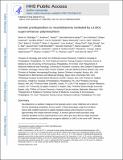| dc.contributor.author | Oldridge, Derek A. | |
| dc.contributor.author | Wood, Andrew C. | |
| dc.contributor.author | Weichert-Leahey, Nina | |
| dc.contributor.author | Crimmins, Ian | |
| dc.contributor.author | Sussman, Robyn | |
| dc.contributor.author | Winter, Cynthia | |
| dc.contributor.author | McDaniel, Lee D. | |
| dc.contributor.author | Diamond, Maura | |
| dc.contributor.author | Hart, Lori S. | |
| dc.contributor.author | Zhu, Shizhen | |
| dc.contributor.author | Durbin, Adam D. | |
| dc.contributor.author | Anders, Lars | |
| dc.contributor.author | Tian, Lifeng | |
| dc.contributor.author | Zhang, Shile | |
| dc.contributor.author | Wei, Jun S. | |
| dc.contributor.author | Khan, Javed | |
| dc.contributor.author | Bramlett, Kelli | |
| dc.contributor.author | Rahman, Nazneen | |
| dc.contributor.author | Capasso, Mario | |
| dc.contributor.author | Iolascon, Achille | |
| dc.contributor.author | Gerhard, Daniela S. | |
| dc.contributor.author | Guidry Auvil, Jaime M. | |
| dc.contributor.author | Hakonarson, Hakon | |
| dc.contributor.author | Diskin, Sharon J. | |
| dc.contributor.author | Thomas Look, A. | |
| dc.contributor.author | Maris, John M. | |
| dc.contributor.author | Abraham, Brian Joseph | |
| dc.contributor.author | Young, Richard A. | |
| dc.date.accessioned | 2017-04-18T13:12:44Z | |
| dc.date.available | 2017-04-18T13:12:44Z | |
| dc.date.issued | 2015-11 | |
| dc.date.submitted | 2015-02 | |
| dc.identifier.issn | 0028-0836 | |
| dc.identifier.issn | 1476-4687 | |
| dc.identifier.uri | http://hdl.handle.net/1721.1/108203 | |
| dc.description.abstract | Neuroblastoma is a paediatric malignancy that typically arises in early childhood, and is derived from the developing sympathetic nervous system. Clinical phenotypes range from localized tumours with excellent outcomes to widely metastatic disease in which long-term survival is approximately 40% despite intensive therapy. A previous genome-wide association study identified common polymorphisms at the LMO1 gene locus that are highly associated with neuroblastoma susceptibility and oncogenic addiction to LMO1 in the tumour cells. Here we investigate the causal DNA variant at this locus and the mechanism by which it leads to neuroblastoma tumorigenesis. We first imputed all possible genotypes across the LMO1 locus and then mapped highly associated single nucleotide polymorphism (SNPs) to areas of chromatin accessibility, evolutionary conservation and transcription factor binding sites. We show that SNP rs2168101 G>T is the most highly associated variant (combined P = 7.47 × 10[superscript −29], odds ratio 0.65, 95% confidence interval 0.60–0.70), and resides in a super-enhancer defined by extensive acetylation of histone H3 lysine 27 within the first intron of LMO1. The ancestral G allele that is associated with tumour formation resides in a conserved GATA transcription factor binding motif. We show that the newly evolved protective TATA allele is associated with decreased total LMO1 expression (P = 0.028) in neuroblastoma primary tumours, and ablates GATA3 binding (P < 0.0001). We demonstrate allelic imbalance favouring the G-containing strand in tumours heterozygous for this SNP, as demonstrated both by RNA sequencing (P < 0.0001) and reporter assays (P = 0.002). These findings indicate that a recently evolved polymorphism within a super-enhancer element in the first intron of LMO1 influences neuroblastoma susceptibility through differential GATA transcription factor binding and direct modulation of LMO1 expression in cis, and this leads to an oncogenic dependency in tumour cells. | en_US |
| dc.description.sponsorship | National Institutes of Health (U.S.) (R01-CA109901) | en_US |
| dc.language.iso | en_US | |
| dc.publisher | Nature Publishing Group | en_US |
| dc.relation.isversionof | http://dx.doi.org/10.1038/nature15540 | en_US |
| dc.rights | Article is made available in accordance with the publisher's policy and may be subject to US copyright law. Please refer to the publisher's site for terms of use. | en_US |
| dc.source | PMC | en_US |
| dc.title | Genetic predisposition to neuroblastoma mediated by a LMO1 super-enhancer polymorphism | en_US |
| dc.type | Article | en_US |
| dc.identifier.citation | Oldridge, Derek A.; Wood, Andrew C.; Weichert-Leahey, Nina; Crimmins, Ian; Sussman, Robyn; Winter, Cynthia; McDaniel, Lee D. et al. “Genetic Predisposition to Neuroblastoma Mediated by a LMO1 Super-Enhancer Polymorphism.” Nature 528, no. 7582 (November 11, 2015): 418–421. © 2015 Macmillan Publishers Limited, part of Springer Nature | en_US |
| dc.contributor.department | Massachusetts Institute of Technology. Department of Biology | en_US |
| dc.contributor.department | Whitehead Institute for Biomedical Research | en_US |
| dc.contributor.mitauthor | Abraham, Brian Joseph | |
| dc.contributor.mitauthor | Young, Richard A | |
| dc.relation.journal | Nature | en_US |
| dc.eprint.version | Author's final manuscript | en_US |
| dc.type.uri | http://purl.org/eprint/type/JournalArticle | en_US |
| eprint.status | http://purl.org/eprint/status/PeerReviewed | en_US |
| dspace.orderedauthors | Oldridge, Derek A.; Wood, Andrew C.; Weichert-Leahey, Nina; Crimmins, Ian; Sussman, Robyn; Winter, Cynthia; McDaniel, Lee D.; Diamond, Maura; Hart, Lori S.; Zhu, Shizhen; Durbin, Adam D.; Abraham, Brian J.; Anders, Lars; Tian, Lifeng; Zhang, Shile; Wei, Jun S.; Khan, Javed; Bramlett, Kelli; Rahman, Nazneen; Capasso, Mario; Iolascon, Achille; Gerhard, Daniela S.; Guidry Auvil, Jaime M.; Young, Richard A.; Hakonarson, Hakon; Diskin, Sharon J.; Thomas Look, A.; Maris, John M. | en_US |
| dspace.embargo.terms | N | en_US |
| dc.identifier.orcid | https://orcid.org/0000-0001-8855-8647 | |
| mit.license | PUBLISHER_POLICY | en_US |
